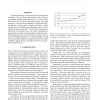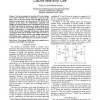18 search results - page 3 / 4 » Reducing leakage power in peripheral circuits of L2 caches |
HPCA
2005
IEEE
14 years 5 months ago
2005
IEEE
If current technology scaling trends hold, leakage power dissipation will soon become the dominant source of power consumption in high performance processors. Caches, due to the f...
CF
2005
ACM
13 years 7 months ago
2005
ACM
Power consumption within the memory hierarchy grows in importance as on-chip data caches occupy increasingly greater die area. Among dynamic power conservation schemes, horizontal...
DATE
2010
IEEE
13 years 10 months ago
2010
IEEE
Abstract— The optimal size of a large on-chip cache can be different for different programs: at some point, the reduction of cache misses achieved when increasing cache size hits...
MICRO
2002
IEEE
13 years 4 months ago
2002
IEEE
On-chip caches represent a sizeable fraction of the total power consumption of microprocessors. Although large caches can significantly improve performance, they have the potentia...
ISCAS
2007
IEEE
13 years 11 months ago
2007
IEEE
- Data in conventional six transistor (6T) static random access memory (SRAM) cells are vulnerable to noise due to the direct access to the data storage nodes through the bit lines...


